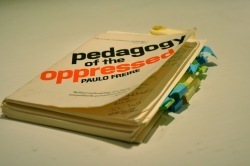Requirements for Dialogue
 Saturday, June 26, 2010 at 10:26PM
Saturday, June 26, 2010 at 10:26PM On Facebook a while back Cathy Toll asked her friends an interesting question: "What books have had the biggest influence on your life?" As I've been working on writing Unmistakable Impact, I realized that a book that should go on that list for me is Paulo Friere's Pedagogy of the Oppressed. I've read the book again and again, and each review rewards me with new insights about how people can work together as partners.

What I uncovered this time--written on just a couple pages in the middle of the book--are his requirements for dialogue. For my book, I used the requirements as the structure for my discussion of dialogue. Here's what I wrote:
Friere has identified five requirements for dialogue: humility, faith, love, critical thinking and hope. Each provides an excellent point of departure for this introduction to dialogue.
Humility. “Men who lack humility (or have lost it) cannot come to the people, cannot be their partners in naming the world … Dialogue cannot exist without humility” (Freire, p. 79). People who take the partnership approach recognize that humility is a necessary precondition for dialogue. After all, if I know it all, what could I possibly learn from you?
Humility is manifested in many actions during dialogue. First, we need to go into conversations as learners more than teachers. When we talk with others with the goal of learning from them, rather than teaching them, our entire way of conversing changes. We begin as listeners and turn the focus onto our partners. During dialogue, the humble communicator is fully present, paraphrasing what is heard, hearing the emotion and meaning of what is said in addition to the actual words.
Humility means, too, that we are more concerned with getting things right than being right. Therefore we ask good questions, real questions, that we don’t know the answer to, and then we listen for the answer. We stop trying to persuade and start trying to learn. As David Bohm has written, “If something is right, you don’t need to be persuaded. If somebody has to persuade you, there is probably some doubt” (Bohm, On Dialogue, p. 15).
Too often our conversations are self-centered rather than learning-centered. When this is the case, we listen for evidence that our conversation partners agree with us, and when people don’t agree, we work hard to show them we are right and they are wrong.
Humility in dialogue often means that we simply withhold our opinion so that we can hear others. This may involve a kind of radical honesty. Rather than covering up the flaws in our argument, or hiding our ignorance, in dialogue, we should display the gaps in our thinking for everyone to see. If we want to learn, we can’t hide behind a dishonest veneer of expertise. Indeed, treating others as equals demands that we tell them truthfully about what we believe, assume, know, and do not know.
In dialogue we humbly let go of the notion that there is only one right answer—our answer!—and we see conversation as a testing ground for ideas. If the purpose of conversation is learning, then the last thing we should be doing is confirming our own misconceptions by solely seeking others who see the world the same as us. As David Bohm has said, “If you are defending a position, you are pushing out what is new” (Bohm, On Dialogue, p.15).
Humility also lays the foundation for one of the most important practices within dialogical conversations—questioning assumptions. Usually, our assumptions go unquestioned, and we assume that what we assume is the truth. We take our assumptions for certainties, and this leads to many conflicts and failures of understanding when we encounter other people whose unquestioned assumptions conflict with ours. Dialogical conversations at their best enable us to explore our assumptions, through conversation, so that we will be better able to learn from others.
Faith. “Faith in man is an a priori requirement for dialogue; the ‘dialogical man’ believes in other men even before he meets them face to face” (Friere, p. 79). When I engage in dialogue, I truly recognize that those I speak with are equal to me, and I work from the assumption that they hold within them wisdom, knowledge, ideas, and gifts. When we take an anti-dialogical approach and tell people what to do without listening, or try to persuade people to do what we think is best for them, without their choice or voice, we show a profound lack of respect for their humanity. Dialogue is never manipulative; it is grounded in free conversation between people who respect each other as equals. If we are equals, then I should value your words as much as I value my own.
When we have faith in others, we let go of the notion that we need to control them, tell them what to do, or hold them accountable. We see people as autonomous individuals deserving of our respect. William Isaacs elaborates on respect in his book Dialogue (1999).
Respect is not a passive act. To respect someone is look for the spring that feed the pool of their experience… At its core, the act of respect invites us to see others as legitimate. We may not like what they do or say or think, but we cannot deny their legitimacy as beings. In Zulu, a South African language, the word Sawu bona is spoken when people greet one another and when they depart. It means “I see you.” To the Zulus, being seen has more meaning than in Western cultures. It means that the person is in some real way brought more fully into existence by virtue of the fact that they are seen (Isaacs, Dialogue, p.111).
When I have faith in my conversation partners, there is a much greater chance, too, that they will trust me. Without mutual trust there is little chance that a conversation will be open enough for dialogue to occur.
Love. “If I do not love the world—if I do not love life—if I do not love men—I cannot enter into dialogue” (Freire, p. 78). Dialogue is only possible if we have empathy for others. In dialogue, we start by being empathetic, respectful, and non-judgmental rather than taking the superior approach and starting by judging others. When we are empathetic toward others, when we move from love rather than control, we recognize our mutual humanity, the great bonds we share with others just because we are all people. This is especially important for people with whom we disagree. Isaacs, again, recognizes empathy as a core part of dialogue:
One lens that can reduce the temptations to blame and increase respect is to listen to others from the vantage point that says, “This, too, is in me.” Whatever the behavior we hear in another, whatever struggle we see in them, we can choose to look for how these same dynamics operate in ourselves (p. 124).
Love is necessary for dialogue but love can also be created by dialogue. As Bohm writes, “love will go away if we can’t communicate and share meaning… However, if we can really communicate, then we will have fellowship, participation, friendship, love, growing, and growth” (p. 41).
Critical Thinking. “Only dialogue … is … capable of generating critical thinking” (Freire, p. 81). When we go into conversation to confirm our views rather than to learn, we choose to think by ourselves rather than with others. If I only want to hear you tell me that you agree with me, then I don’t really want to hear your thoughts at all. If we really want to learn from a conversation, we are wise to go into it looking for ideas that disprove our way of thinking rather than looking for confirmations that our opinion is right.
Dialogue is the thinking approach to communication. In the best situation, our ideas flow back and forth so freely that we truly start to think together, we reach a point where we lose sight of whose ideas are whose. Such conversation is energizing, humanizing, and the most natural way for partners to communicate.
Hope. “Dialogue cannot be carried on in a climate of hopelessness. If the dialoguers expect nothing to come of their efforts, their encounters will be empty, sterile, bureaucratic and tedious” (Freire, p. 80). Dialogue cannot occur when people are paralyzed by hopelessness. Dialogue can only flourish in situations where there are many possibilities.
In part, this means, that a conversation that is dialogical can only be so when it is open-ended. If I come to you with a plan and I expect you to implement it, I am clearly not engaging in dialogue. Dialogue occurs when we start by trying to understand together, when we listen and learn rather than tell and resist.
Hope too, for me at least, means that even act of dialogue is a hopeful act, a sign that we believe a better future is possible. When I listen to you, and you listen to me, we are better for the experience, and there is always the hope that we can create something new and better, that we can advance thought, and, through dialogue, create a better tomorrow.


